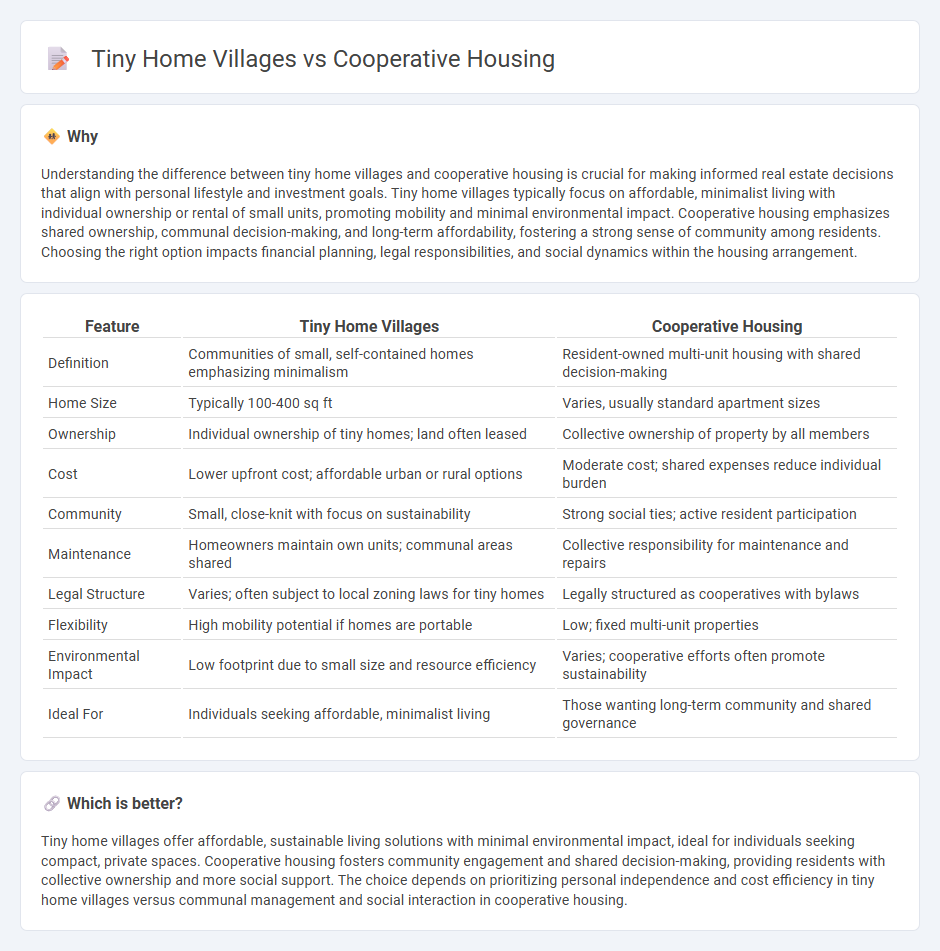
Tiny home villages offer affordable, space-efficient living with a focus on sustainability and community, often appealing to those seeking minimalist lifestyles and lower environmental impact. Cooperative housing emphasizes shared ownership and democratic management, fostering strong social ties and equitable decision-making among residents. Explore the benefits and challenges of both to determine which housing model suits your lifestyle and investment goals.
Why it is important
Understanding the difference between tiny home villages and cooperative housing is crucial for making informed real estate decisions that align with personal lifestyle and investment goals. Tiny home villages typically focus on affordable, minimalist living with individual ownership or rental of small units, promoting mobility and minimal environmental impact. Cooperative housing emphasizes shared ownership, communal decision-making, and long-term affordability, fostering a strong sense of community among residents. Choosing the right option impacts financial planning, legal responsibilities, and social dynamics within the housing arrangement.
Comparison Table
| Feature | Tiny Home Villages | Cooperative Housing |
|---|---|---|
| Definition | Communities of small, self-contained homes emphasizing minimalism | Resident-owned multi-unit housing with shared decision-making |
| Home Size | Typically 100-400 sq ft | Varies, usually standard apartment sizes |
| Ownership | Individual ownership of tiny homes; land often leased | Collective ownership of property by all members |
| Cost | Lower upfront cost; affordable urban or rural options | Moderate cost; shared expenses reduce individual burden |
| Community | Small, close-knit with focus on sustainability | Strong social ties; active resident participation |
| Maintenance | Homeowners maintain own units; communal areas shared | Collective responsibility for maintenance and repairs |
| Legal Structure | Varies; often subject to local zoning laws for tiny homes | Legally structured as cooperatives with bylaws |
| Flexibility | High mobility potential if homes are portable | Low; fixed multi-unit properties |
| Environmental Impact | Low footprint due to small size and resource efficiency | Varies; cooperative efforts often promote sustainability |
| Ideal For | Individuals seeking affordable, minimalist living | Those wanting long-term community and shared governance |
Which is better?
Tiny home villages offer affordable, sustainable living solutions with minimal environmental impact, ideal for individuals seeking compact, private spaces. Cooperative housing fosters community engagement and shared decision-making, providing residents with collective ownership and more social support. The choice depends on prioritizing personal independence and cost efficiency in tiny home villages versus communal management and social interaction in cooperative housing.
Connection
Tiny home villages and cooperative housing are connected through their shared focus on affordability, sustainability, and community-oriented living. Both models emphasize efficient use of space, reduced environmental impact, and collaborative decision-making among residents. This synergy creates accessible housing alternatives that foster social interaction and resource sharing within urban and rural real estate markets.
Key Terms
Cooperative Housing:
Cooperative housing offers shared ownership and democratic management where residents collectively control decision-making, enhancing community engagement and affordability. Unlike tiny home villages, cooperative housing typically involves larger, multi-unit buildings with long-term residency and access to communal resources. Explore how cooperative housing models create sustainable and inclusive living environments by learning more about their benefits and structures.
Shared Ownership
Cooperative housing offers shared ownership where residents collectively own and manage the property, fostering community decision-making and long-term affordability. Tiny home villages, often operated through cooperative or communal models, provide individual ownership rights within a shared space but emphasize minimalistic, sustainable living. Explore the benefits and challenges of shared ownership in these innovative housing options to find the best fit for your lifestyle.
Board Approval
Board approval in cooperative housing often involves a structured voting process by members to ensure alignment with collective goals and financial commitments, reflecting communal decision-making. Tiny home villages, while sometimes governed by community boards, typically have more flexibility and faster approval processes due to smaller scale and independent ownership models. Explore the nuances of board governance in both housing types to understand which model suits your community needs.
Source and External Links
Housing cooperative - Wikipedia - A housing cooperative is a legal entity owning residential real estate, where members buy shares granting them occupancy rights and collective control, differing from traditional homeownership or renting.
Housing Co-ops - Cooperatives for a Better World - Housing co-ops empower residents with collective ownership and management of buildings or land, offering more affordable and stable housing by sharing costs and responsibilities equally among members.
How to start a housing co-op - Shareable - Housing co-ops reduce costs by eliminating landlord profits and sharing resources, often supported by public subsidies, and can transform communities by providing affordable, eco-friendly, and cooperative living environments.
 dowidth.com
dowidth.com